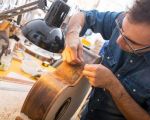How to Care for Your Woodwind Instrument
As a woodwind player myself, I’ve learned that the key to maintaining the quality of your instrument is proper care and attention. Whether you play the flute, clarinet, saxophone, or any other woodwind instrument, it’s essential to keep it in top condition to ensure optimal performance. Over the years, I’ve discovered several important steps to take when caring for my woodwind, and in this article, I’ll share the methods that have helped me keep my instrument sounding as good as new.
1. Clean Your Woodwind Regularly
One of the most important steps in maintaining a woodwind instrument is regular cleaning. After each practice or performance, I make sure to thoroughly clean my instrument to remove moisture, saliva, and any debris that might accumulate inside. The first thing I do is use a cleaning swab, which I gently push through the body of the instrument. The swab absorbs any moisture inside the instrument, preventing rust and mildew from forming.
For my clarinet, I use a swab specifically designed for the bore. If you play the flute, a soft cloth or microfiber cloth can be used to wipe down the inside of the tubes and remove any excess moisture. I’ve noticed that if I skip this step, the pads can become damp, leading to potential issues with the tone and functionality of the instrument.
2. Clean the Mouthpiece
The mouthpiece is one of the most crucial parts of a woodwind instrument, and keeping it clean is key to both hygiene and performance. I clean the mouthpiece of my clarinet and saxophone after every session. I use a mild soap solution and a mouthpiece brush, which allows me to remove any buildup inside the mouthpiece. This buildup can affect airflow, resulting in poor sound quality and tone.
For my flute, I simply wipe down the headjoint with a soft cloth to remove any moisture. It’s important to make sure there’s no buildup inside the mouthpiece, as this can lead to poor tone production or even clog the instrument. A clean mouthpiece also helps maintain hygiene, which is especially important if you share your instrument with others.
3. Maintain the Pads and Corks
Another essential element of woodwind maintenance is caring for the pads and corks. Over the years, I’ve learned that the pads on my clarinet and saxophone need special attention. These pads are responsible for sealing the tone holes and ensuring that the instrument plays correctly. If they become too wet, damaged, or dirty, they can cause leaks and affect the sound quality. To prevent this, I make sure to keep the pads dry and wipe them down carefully using a clean cloth.
For the corks on the joints of my woodwind instrument, I use cork grease. A small amount of grease keeps the corks in good condition, allowing the joints to slide together smoothly without damage. When applying cork grease, I make sure to wipe away any excess to prevent the cork from becoming too slippery. This simple step extends the life of the cork and makes assembly and disassembly much easier.
4. Store Your Instrument Properly
How you store your woodwind instrument plays a major role in its longevity. When I’m not using my instrument, I always make sure to store it in a hard case to protect it from dust, dirt, and accidental damage. A hard case provides solid protection, especially if you travel frequently with your instrument. Additionally, I always leave the case open for a short time after playing to allow any moisture inside the instrument to evaporate, preventing mold or rust buildup.
For the woodwind instruments made of wood, such as clarinets, I ensure that they are not exposed to extreme temperatures or humidity. Extreme dryness or dampness can warp the wood, leading to cracks or damage. That’s why I keep my clarinet in a climate-controlled area and avoid leaving it in direct sunlight or near heat sources, as this can harm the instrument over time.
5. Regularly Check for Leaks and Damage
One of the most important things I do to maintain my woodwind instrument is to regularly check for leaks or damage. I make sure to look over all the pads and joints for any signs of wear or damage. Leaks can occur if the pads are worn out or if there’s a crack in the instrument’s body. If I suspect there’s a leak, I use a simple leak light to check for any gaps in the pads and to make sure they are sealing properly.
If I notice any issues with the pads, corks, or keys, I take my instrument to a professional repair technician. Regular maintenance by a technician can save me from more costly repairs down the line and ensures my instrument continues to play smoothly. I’ve learned that preventing small issues from turning into major problems is key to keeping my woodwind in top shape.
6. Replace Reeds Regularly
If you play a reed instrument like the clarinet or saxophone, one of the most essential parts of your instrument is the reed itself. Over time, reeds wear down and lose their ability to vibrate properly, resulting in a dull or weak sound. I’ve found that regularly replacing my reeds is essential for achieving a full and vibrant sound. I keep a stash of reeds on hand, ensuring that I always have a fresh one ready for each practice session or performance.
I also make sure to properly store my reeds. After each use, I rinse the reed with water and let it dry fully before placing it in a reed case. Storing reeds in a dry, well-ventilated case helps prevent warping and cracking, ensuring that the reeds last longer and perform better. If you find that your reed is not working as it should, it’s time to replace it, as a bad reed can seriously affect your performance.
7. Keep Your Instrument in Tune
Finally, I make sure to keep my woodwind instrument properly tuned. Whether I’m tuning before a performance or just for practice, I use a tuner to ensure that my instrument is in perfect pitch. Regular tuning is essential to maintaining the overall sound quality of the instrument. I’ve learned that even small adjustments can make a huge difference in how the instrument sounds, especially for woodwinds like the flute and clarinet, which rely heavily on precise tuning for a clean, clear tone.
Regular tuning not only helps with performance but also helps prevent strain on the instrument’s components. An instrument that’s properly tuned is easier to play, and it sounds better, which is essential for achieving the best performance possible.








